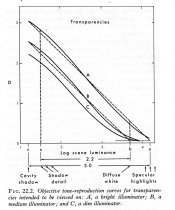I think it partly a manifestation of my point that the zone system is mathematically inconsistent, together with a dose of ill-defined parameters.
.
Adams was never as technical as his reputation suggests. The problem with the Zone System vs Tone Reproduction is the Zone System has some assumptions that differ. One of the results is the Zone System EI rarely equals the ISO speed. While it was in closer agreement prior to the 1960's film speed change, the underlying assumption was still off. Film speeds before 1960 were around 1/2 to 1 stop slower resulting from the inclusion of a safety factor. The 1960 standard eliminated most of that factor. The principles from that standard haven't changed. Since the Zone System never changed its testing procedures, a 1/2 to 1 stop difference in speed between the two methods exists. Contrary to the 50 plus years of speculation, Zone System testing doesn't represent the true film speed, nor do the film manufacturers tweet their results to make the films look better. And laboratory test can equate to real world results.
The idea of metering a target and stopping down to determine film speed, while prone to experimental error, can be a generally effective method, but only when the relationship between the metered exposure point and the film speed point is known. The Zone System's four stops down from the metered exposure point is simply different from the ISO's 3 1/3 difference between H
m and H
g. Exposure at the metered point is 8 / H
g. For a 125 speed film, H
g = 8/125 = 0.064 lxs. Per the ISO speed equation, film speed calculated as 0.8 / H
m. For a 125 speed film, 0.8/H
m = 8/125 = 0.0064 lxs. The difference between H
g and H
m is 10X, 1.0 log-H, or 3 1/3 stops. The Zone System's 4 stops or 1.20 log-H will fall below the speed point. No conspiracy. Just two different methods. One of which, never accurately defined itself.
The 1/2 to 1 stop increase in exposure with the Zone System, makes Zone V effectively 18% Reflectance, but only under statistically average conditions or in scenes with certain tonal distribution Of course, as the negative is over-exposed, any adjustments to compensate for it in printing will negate the alignment with 18%.
Zone System assumes it incorporates flare in the testing because incorporates a camera's optical system in the test. This might appear to be a logical assumption except flare is caused by scattered light from the higher luminances to the lower luminances. Zone System testing includes a single toned target, usually middle gray. Even under normal flare conditions, flare at the exposure mid-point is small compared to the shadows. In combination, in camera testing would produce little to no flare. Under statistically average conditions, normal flare is about a stop. In practice, the resulting exposure based on Zone System testing will be even higher with the addition of flare.
Flare also comes into play when determining an aim gradient or negative density range. While in practice, the difference between the statistically average luminance range of 2.20 and the Zone Systems 2.10 is only a 1/3 or a stop, the shorter Zone System range can cause problems with the math. A scene with a luminance range of 2.20 logs will have an illuminance range at the film plane of 1.90 logs. Development is determined by what the film sees. Kodak considers normal development to be between CI 0.56 and 0.58. Aim Contrast Index = Negative Density Range / Log Subject Luminance range - Flare. If the aim CI is 0.57 and the average scene is 2.20 log units, the aim negative density range is 1.25. Adam's The Negative has around 1.25 as the aim for a normally developed negative. The CI aim for the Zone System corresponds to Kodak's, except the Zone System doesn't factor in flare and Kodak does, and Kodak has a resulting density range of 1.05 for a normal negative. Again, the Zone System has made an assumption which is technically inaccurate, but renders good results. For one, the Zone System uses a luminance range 1/3 stop smaller than the statistically average. Moving 2.10 log units to the right of the fixed density point of 0.10 will indicate a higher density range than a point 1.90 log units from 0.10, but the gradient of the curve is the same. The only difference is how the numbers are determined, not which method best represents reality. So while the test might indicate a negative density range of 1.25, the resulting development will produce a negative density range of 1.05 for statistically normal scene matching the negative's density range to a grade two paper's LER.
We've already discussed the meter. It actually doesn't see Reflectance. It reads Luminance. What it wants to do is make an exposure of 8/ISO at the film plane. When the 2.20 luminance range has a diffused highlight at 100% Reflectance under Sunny 16 conditions, the luminance at the metered exposure point will have an effective Reflectance of 12%. The Zone System calling it 12 or 18 isn't going to make a difference at the film plane.







